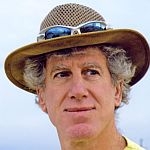 (HOST) Commentator Ted Levin recently read a book that surprised him by revealing a connection between the decline of the American Buffalo and post-Civil War Vermont.
(HOST) Commentator Ted Levin recently read a book that surprised him by revealing a connection between the decline of the American Buffalo and post-Civil War Vermont.
(LEVIN) A number of years ago, the National Geographic Society sent me to South Dakota to write a story about the Great Plains. Why they chose me for that assignment still remains a mystery. I hate to mow the lawn and weed whacking – if I can ever get the plastic string properly threaded – is one of my least favorite homeowner’s chores. I rank it lower than scrubbing shower tile, lower even than cleaning carpet stains.
I’ve been thinking a lot about those expansive grasslands and one creature in particular that lives there – ever since I finished reading American Buffalo: In Search of a Lost Icon, Steve Rinella’s personal tale of an Alaskan buffalo hunt bound in a reflective study of how the buffalo shaped our national identity.
As recently as the1800s, 40 million American buffalo, scientifically known as Bison bison, roamed a million square miles of interior grasslands and Appalachian valleys from Virginia in the east to Alaska in the north. No other large land mammal has ever been more numerous, or exerted more of an influence on its native landscape.
Once, when I was wandering through Wind Cave National Park, I found a buffalo skeleton, an old bull with grass-worn teeth. The plains were greener around the bones, having been fed by the buffalo’s remains. Calcification in the sun-bleached ribs marked the site of an injury, and several cervical vertebrae had fused together in an arthritic lump. The vertebrae had been compressed under the enormous force of shoving bouts – in which lusty bulls slammed into each other face first at speeds up to 35 miles an hour; the old bull’s ribs, broken when a contestant’s head slammed his side, testified to the power of the procreative urge.
Although this animal appeared to have died a natural death, beginning a 140 years ago, millions of buffalo were slaughtered for their thick, soft hide, their carcasses left to rot beneath the prairie sun. According to Rinella, one hide hunter stood above the rest, Vermonter J. Wright Mooar – spelled m-o-o-a-r. Born in Pownal in 1851, Mooar headed west shortly after the Civil War, and got started in the buffalo business supplying the troops at Fort Hays, Kansas with fresh meat. After moving to Dodge City, Mooar sold buffalo meat to the Santa Fe Railroad. When hides became more lucrative than meat he filled orders for local tanneries, freighting surplus hides to his brother in New York City. Eventually, his brother placed orders for "as many as we can get." And when the price of a hide rose to $3 a piece, Mooar hired additional hunters and skinners, and established a buffalo-killing firm. By the late 1880s, the buffalo were wiped out, and Mooar had personally killed twenty-five thousand of them, so many, so quickly that the barrel of his Springfield rifle would get too hot to touch.
Eventually, J. Wright Mooar, the sharp-shooter from Vermont, settled on a cattle ranch in Scurry County, Texas, leaving the Great Plains littered with buffalo bones, providing a final bonanza for the bone meal merchants.